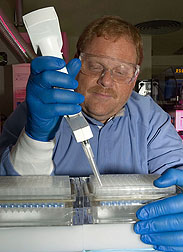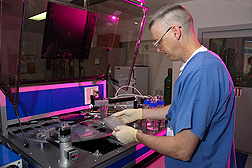New Leptospirosis Discovery!
Changes seen in pathogen’s
ability to survive outside a host.
The bacterial species that commonly causes leptospirosis in cattle has lost much of its ability to survive in water.
This change, discovered by scientists at ARS’s National Animal Disease Center (NADC), in Ames, Iowa, and at Monash University in Melbourne, Australia, is likely affecting the ability of this microbe, Leptospira borgpetersenii serovar Hardjo, to spread through the environment.
Leptospirosis is among the most widespread of zoonotic diseases, which are infections transmitted naturally from domestic or wild animals to people.
L. borgpetersenii is one of two leptospiral species associated with most cases of bovine leptospirosis worldwide, and it is responsible for most cases in North American cattle. The other species is L. interrogans.
“Our results suggest that L. borgpetersenii is now spread mainly, if not solely, through close contact with infected animals,” says NADC microbiologist Richard Zuerner. “The research also shows that L. interrogans is still able to spread easily through contaminated water.”
What’s the Difference?
Zuerner says that, before this study, evidence was lacking that L. borgpetersenii and L. interrogans differed in ways that would affect their survival in the environment. “Now we have a foundation for studying how the disease-transmission processes of both species differ,” he says. “It’s a step toward better disease-control strategies that may include changes in farm management and vaccine design.”
There’s great demand for better control of leptospirosis, in large part because current vaccines effectively guard only against infection by the serovars, or subgroups, that are used in making them. “This provides limited cross protection,” says Zuerner. “A benefit of obtaining the L. borgpetersenii genome sequence is that we can use it to identify proteins that may be incorporated into new, more effective vaccines.”
Leptospirosis is broadly distributed in wildlife and persists in livestock. Each serovar appears to be adapted to a particular animal species in which it causes problems with pregnancy and fertility but usually doesn’t cause severe disease. For example, serovar Hardjo is less likely to cause severe infections in adult cattle—its normal maintenance host—but it can cause abortion, stillbirth, or weakened offspring.
“In contrast, when Leptospira infect humans, the disease ranges from mild, flulike symptoms to a potentially lethal infection resulting from pulmonary hemorrhage or organ failure,” says Zuerner.
People and animals are commonly infected with Leptospira by exposure through water contaminated with urine from infected animals. Direct contact with body fluids or tissue from infected animals is another common way to contract the disease.
|
|
Sequencing Opens the Door
The recent finding was the result of genomic sequencing studies of L. borgpetersenii conducted at NADC byZuerner and veterinary medical officer David Alt, at Monash by scientists Ben Adler and Dieter Bulach, and at the University of Queensland’s Australian Genome Research Facility under the direction of Elizabeth Kuczek. Zuerner and Bulach analyzed the data with support from Torsten Seemann, a research fellow at the Victorian Bioinformatics Consortiumat Monash.
In the report describing their discovery, the researchers explained that the L. borgpetersenii genome is decaying.
“The species carries a large number of defective genes as compared to L. interrogans,” says Zuerner. “This loss of functional genes is thought to impair both the bacterium’s ability to sense changes in the environment and its capacity to acquire nutrients and survive outside a mammalian host. We concluded that L. borgpetersenii is evolving toward dependence on a strict host-to-host transmission cycle.”
In contrast, Zuerner says, most other Leptospira species can be transmitted through surface water. “This is a contributing factor to epidemics in human populations that coincide with heavy flooding, especially in underdeveloped countries with inadequate wastewater control,” he says.
Zuerner explains that while L. interrogans strains are also found in livestock, they’re often associated with disease occurring during seasonal flooding from chronically infected rats.
He says the initial steps involved in the evolutionary process leading to host dependence are unclear, but identifying them is important.
“If we can characterize the changes that lead to this reliance, it should help identify early events that lead to host dependence among a large variety of other bacterial pathogens,” says Zuerner.
The microbiologist, who works in NADC’s Bacterial Diseases of Livestock Research Unit, isa seasoned leptospirosis researcher. A decade ago, he developed new tests that precisely identify Leptospira strains from different host-animal species. That key advancement made it possible to pinpoint the source of infections from a variety of animal species.
An Outbreak in Sea Lions
In 2004, Zuerner worked with many scientists spread along the Pacific Coast to investigate the deaths of more than 300 sea lions. NADC studies ultimately showed that the animals were infected with L. interrogans serovar Pomona.
“That was a notable outbreak because it killed a significant number of marine mammals, including endangered or protected species,” says Zuerner. “It also helped show how animal migration may spread leptospirosis.”
Zuerner says that the new findings with L. borgpetersenii may eventually have application outside of leptospirosis.
“Presumably, the mechanism that impaired its ability to survive outside the host and started it on its path toward host dependence is shared by other bacterial genera,” he says.
“It seems that an early step in the process of becoming dependent on a host for survival is the disruption of sensory functions. If bacteria can’t differentiate between being in the host and being in water, it’s likely they’ll be ill-prepared for the challenges of living in a nutrient-deficient environment.”—By Luis Pons, formerly with ARS.
This research is part of Animal Health, an ARS national program (#103) described on the World Wide Web at www.nps.ars.usda.gov.
Richard L. Zuerner is in the Bacterial Diseases of Livestock Research Unit, USDA-ARS National Animal Disease Center, 2300 N. Dayton Ave., Ames, IA 50010; phone (515) 663-7392, fax (515) 663-7458.
"New Leptospirosis Discovery!" was published in the August 2007 issue of Agricultural Research magazine.









